Garden Glimpses: Daffodil Daze
It’s been an odd spring (what else is new?), with temps ping-ponging up and down through March and April. But strangely, the weirdness seems to have worked well for my daffodils, with early, middle and late season varieties blooming more or less together. I don’t know when I’ve seen such diversity on display all at once, and it’s made for a lovely panoply of color and form across the garden.
As always, there have been winners and losers in the garden roulette. Some varieties of narcissus have over-performed, some have held their own, others are declining. I’ll be doing a bit of judicious upheaval later this spring, as I dig up clumps of underperformers, split them, and try them in new locations, to see if lack of sun is the issue, or they’re just plain stinkers.

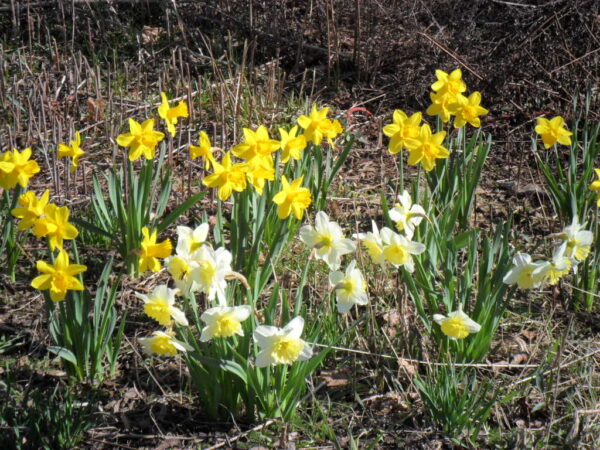
You see, while all my daffodils bloom in full sun, by the time their flowers are gone and they’re ready to take in nourishment for next year’s supply, many are in shady areas, as the maple and birch leaf out overhead. So the blady narcissus leaves that capture the solar energy so vital for flower production are not as fully exposed to it as they’d like. With some varieties, this isn’t really an issue; others gradually fail.

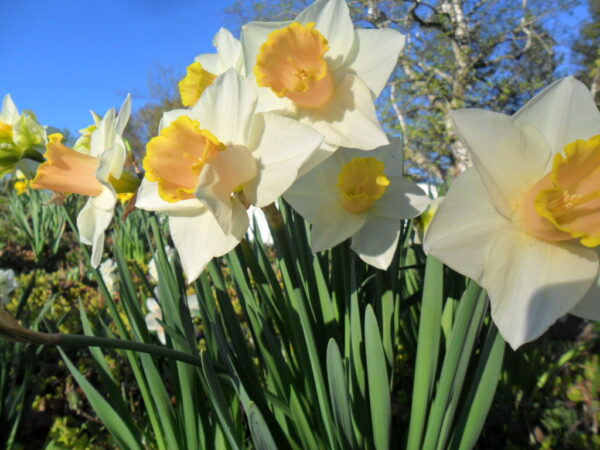

The problem, of course, is that I like my daffs where I plant them! That’s why they are, where they are! But as a gardener with fifty-plus years’ experience of this property, I’ve learned you can’t fight City Hall. Or in this case, Mother Nature. So although it’s a huge pain in the rhizome to dig up these guys and move them, and although breaking up my carefully crafted garden design revolts my aesthetic sense, the fiscal realist in me also acknowledges that expensive bulbs that are not giving bloom are doing nobody any good. So move them I shall.
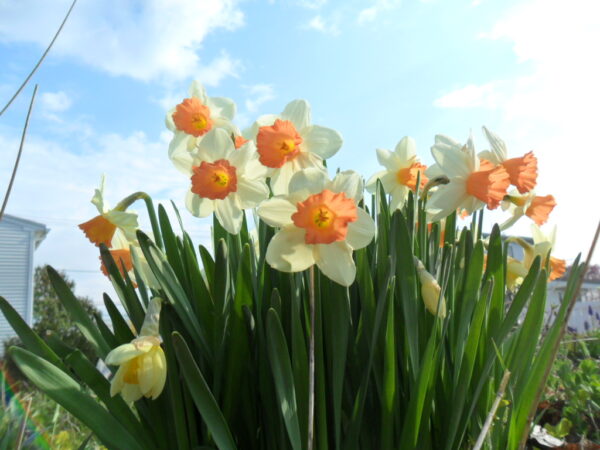
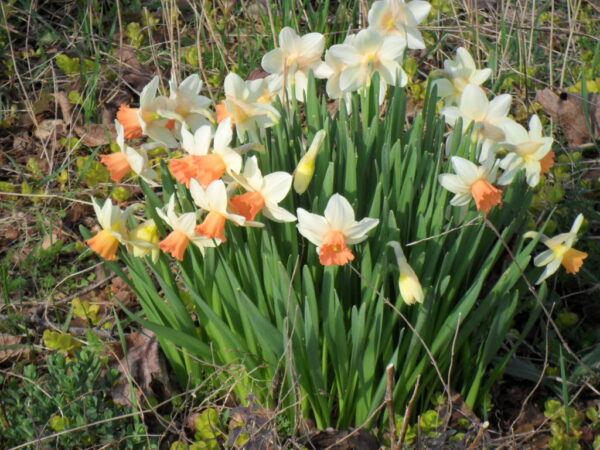

But that unpleasant task is still a few weeks away, and in the meantime I can enjoy the fruits of my prior labors. Being a Virgo Moon perfectionist, I like to kvetch about the underperformers and disappointments, but truly, when I step back and view the larger picture, it’s truly astounding how far we’ve come in just five years. The March and April landscape is a patchwork quilt of white, yellow, pink and purple, a kaleidoscopic, ever-shifting bounty that grows more lovely by the year.
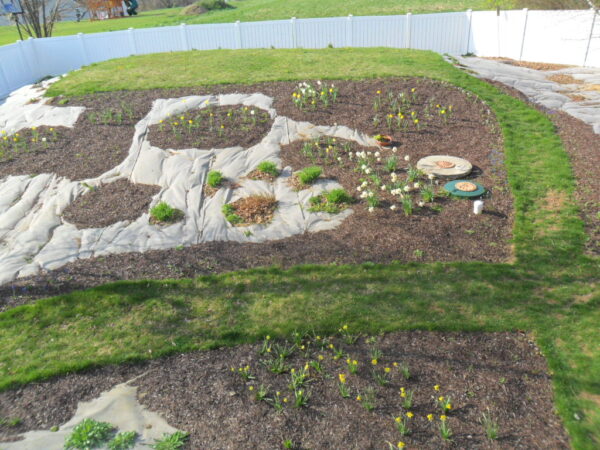

I like to think I can identify all my babies on sight, but the truth is I now have a lot of floral offspring, my retentive mental powers aren’t what they used to be, and the original planting charts are soiled and fading. So bear with me as we tour the largely nameless, but lovely-faced, springtime denizens of my garden.

British Gamble is one narcissus whose name is so unique, I don’t think I’ll ever forget it. Far and away the largest-flowered variety in my collection, this pastel stunner opens with off-white petals surrounding a trumpet that starts in pinky peach at the rim, bleeding into pale yellow that deepens as it descends into the trumpet’s base. As it ages, these colors become paler and fade until the bloom appears essentially all-white, but this can take awhile, and British Gamble is also the record-holder for longest-lived blossom in my garden. If weather conditions are right, the blooms can last up to month, and their performance in cut bouquets is also outstanding, remaining fresh indoors for as much as a week. If BG has one flaw (and it does), it’s that the extreme size of its blossoms makes them top-heavy, and prone to flopping, especially if the weather is dry and they’re not fully hydrated, or extremely wet and they become rain-sodden.

In the main, yellow- or yellow-and-orange-colored narcissus tend to bloom earlier, exiting the stage just as more exotic varieties in white, pink and peach emerge. This year there’s been a bleed-through, particularly among the large planting beds of early yellow daffs on the sandmound, which remained vibrant much later than typical, just now starting to fade. The rotating bouts of above-normal and below-normal temps created a floral push me-pull you that simultaneously advanced some types and retarded others, so that narcissus which might normally be just ships that pass in the night have had some time to get to know each other.
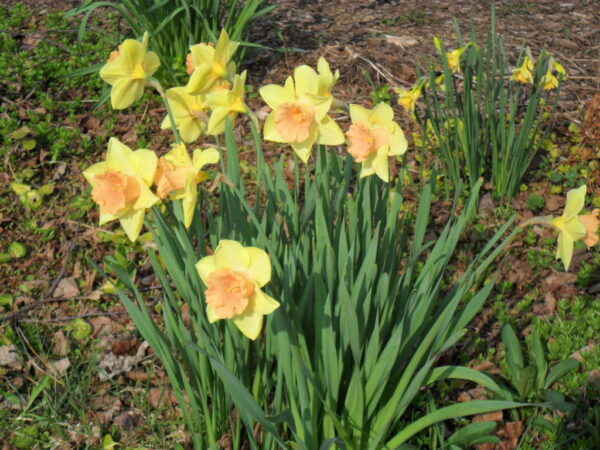
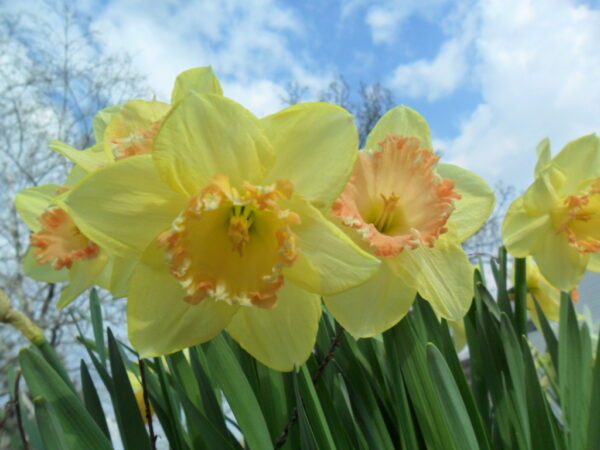
I find that, generally speaking, bulbs planted on the sandmound top do pretty well, as do those at the bottom, where the topography reverts to its natural state. But those on the slope can suffer, and my working theory is that the drought in the summer is more severe here, as what rain there is, tends to run off the slope rather quickly, the resultant dryness affecting the dormant bulbs and retarding their expansion.

Well, that’s my story, anyway, and I’m sticking to it! Whatever the cause, expansion of these three large patches of early yellows has been agonizingly slow, but their brethren topsides and in the valley below are filling in nicely.
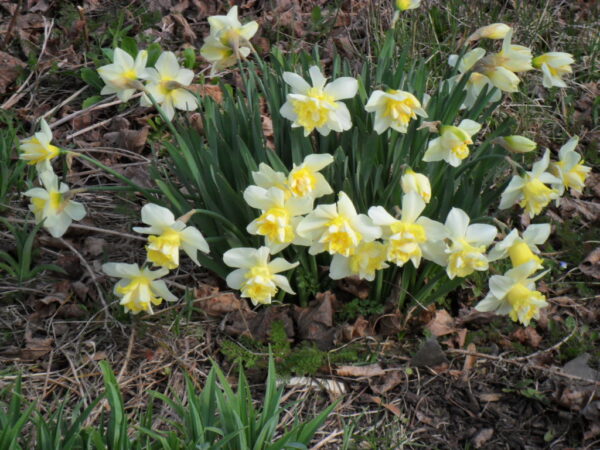
I have no complaints in the performance of this next variety I’m showcasing, though I can’t tell you what to buy if you like it. This time it’s not my memory at fault, but the grower. I found these three years ago at a local Produce Junction stocked with Easter flowers. The tag on the tightly budded plant was marked simply “daffodil” (I mean, why bother, right?), but the minuscule picture provided looked promising, so I gave them a whirl.
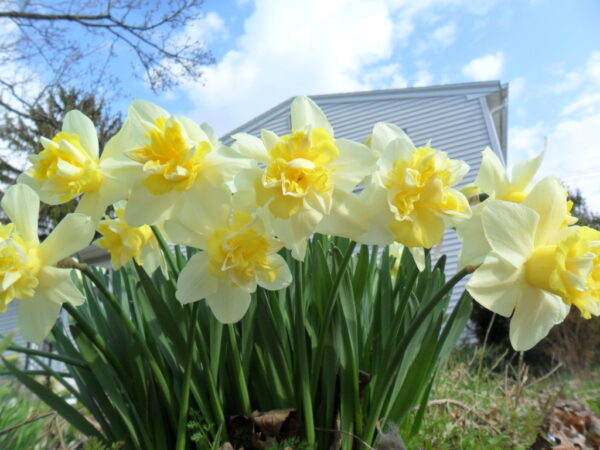
I was so pleased when they opened a week or so later! Another off-white-frilled variety, the cups are a folded, slashed, thickly populated profusion of butter yellow and white. Simply stunning, and quite unlike anything else I have. I always plant potted bulbs right after their bloom has faded, and these have done well in the soil, developing into a healthy cluster in just three seasons. I just wish I knew how to get more!
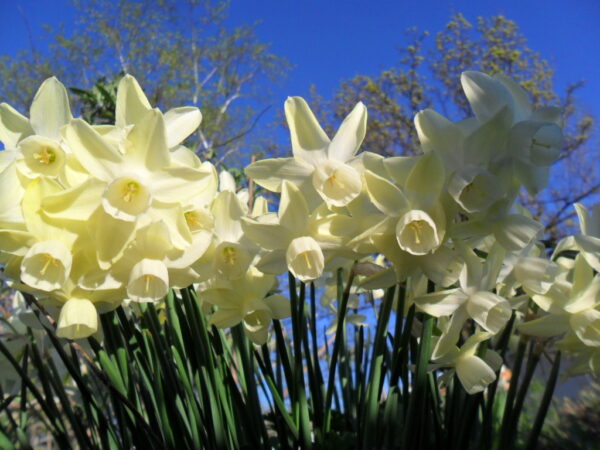


Some of the smaller-flowered narcissi are among my favorites, and many have the advantage of providing multiple blooms per stem. I have my adored mini-daffodils from early spring, of course, the Tete-a-Tetes and Jet Fires. But then, after a wee gap, the later-blooming minis start to kick in, in such varied tones. These are “mini” largely in the sense of flower proportions, having normal-sized leaves and heights in the standard range, if on the shorter side. I have smaller narcissus ranging from solid white or pale yellow to white with palest peach or pink centers, pale yellow with apricot cups, deep gold with white cups, and my favorite color combination, bright yellow with gleaming orange trumpets.


Thalia is another variety that I’ve cultivated for years, in several locations. Here I have four nicely-developed groupings, scattered about the garden in strategic spots. Pure white, their pointed petals give them an almost starlike appearance, and they also offer multiple blooms per stem, in an atypically large flower for that trait.

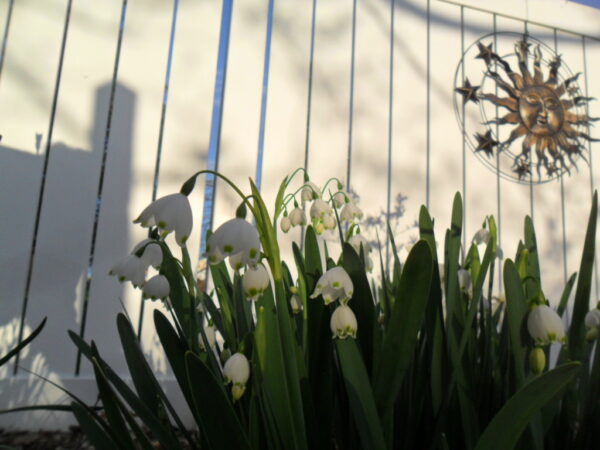
One of my all-time favorite “daffodils” isn’t a narcissus at all, despite having identical foliage. It’s Leucojum, commonly known as Summer Snowflake, with rows of pendant, pristine white bell-shaped blossoms per stem, dotted with green at the tip of each petal. These lovelies have traveled with me from home to home for decades, in postage-stamp backyards, and when I arrived here, I invested in the sprawling space with a dozen new bulbs for a patch on the sandmound. Unfortunately, it’s on the slope, and they are struggling there, though the initial planting under the eaves of the maple is thriving. After five seasons, it’s probably time to dig up the underperformers, consolidate them into a single mass, and try a new spot.
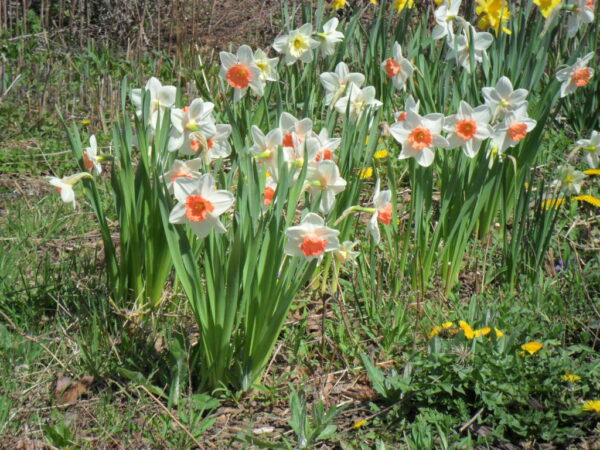
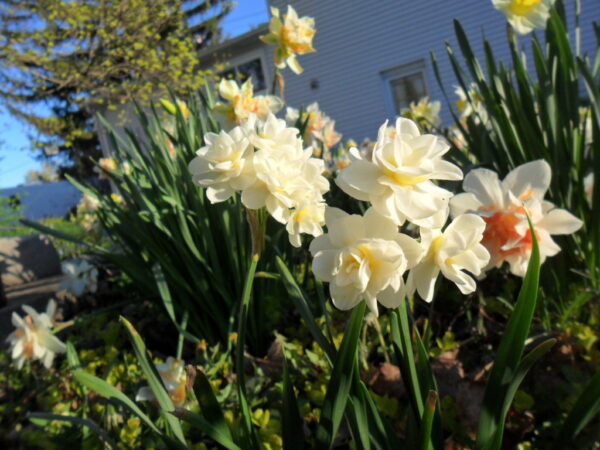
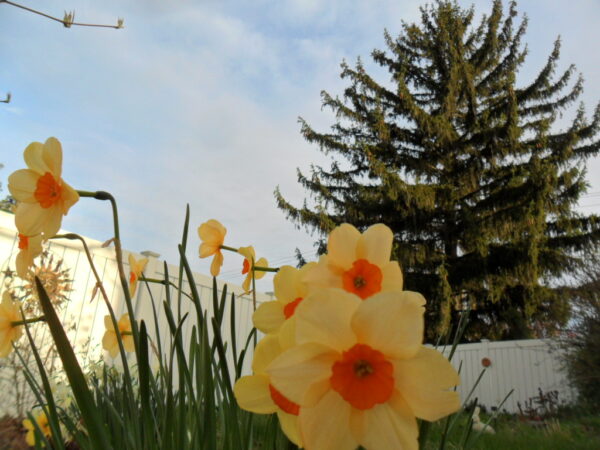
But spring isn’t all about daffodils, despite what my garden inventory suggests. Hyacinths are another beautiful harbinger of the season, and I have quite a few of these scattered about, some new, some heirlooms from my parents’ day. Colors range from white through pale yellow, several tones of pink, apricot, blue and mauve.
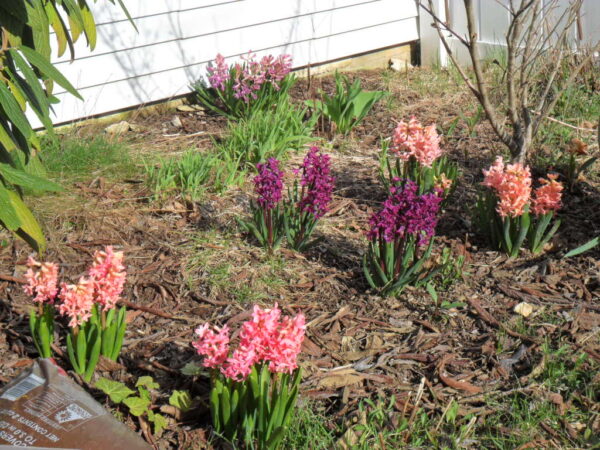
It took me quite a bit of searching to find a match for the pale-yellow hyacinths that adorned my grandmother’s foundation beds when I was a child. Most modern cultivars are too bright, but this one approximates the color I remember.
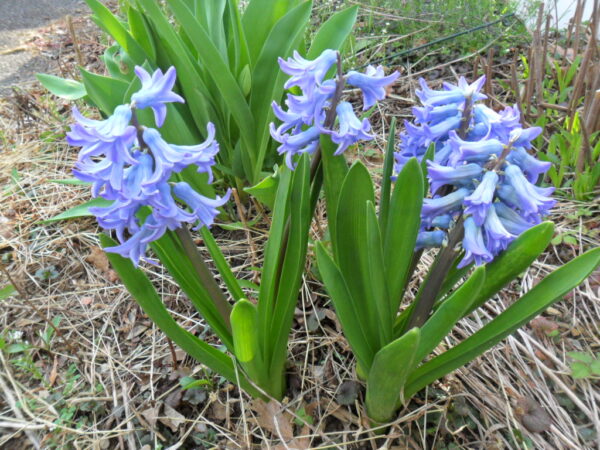
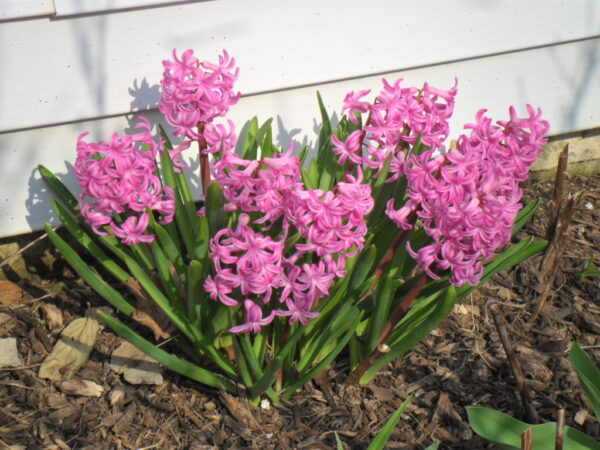
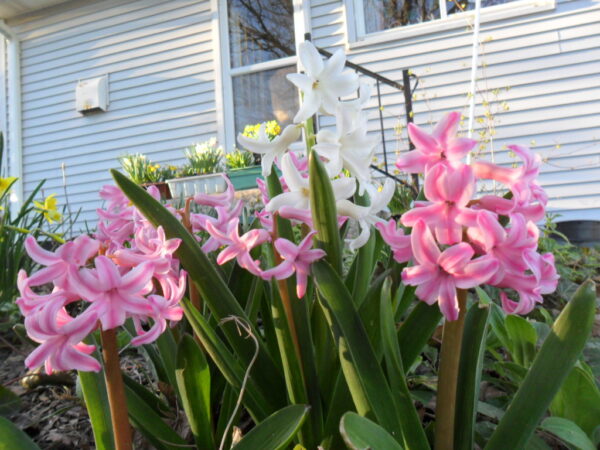
Not a fan of blue in the garden generally, I typically eschew the standard blue hyacinth (though there are still heirlooms in this shade on the property), but I did find a paler, still bright, blue that I quite liked, several years ago. Paired with pastel pink, it looks like an April Baby Shower in the small bed by the garage door, just outside the garden gate.

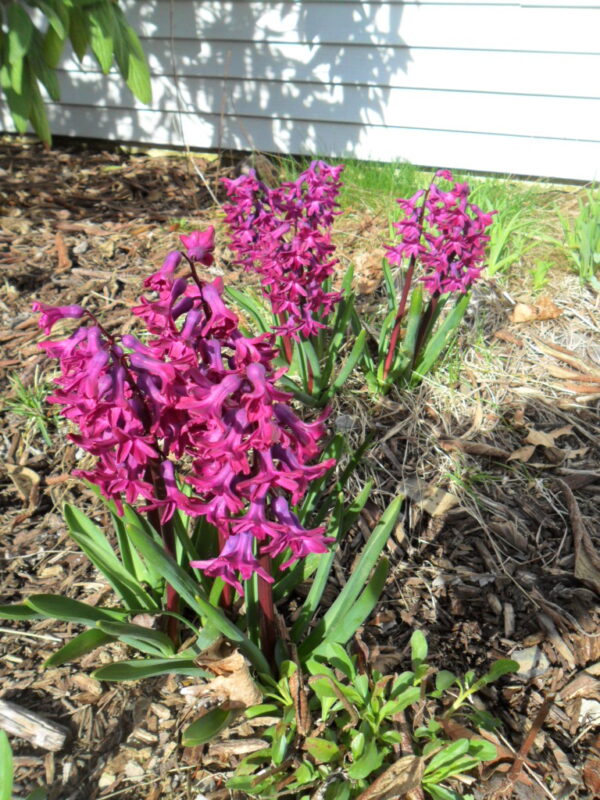

I positively revel in the apricot, peach, pink, lavender and mauve hyacinth combination patch beneath my witch hazel tree in the east bed. My favorite is Woodstock, a vivid deep burgundy-mauve that fairly glows in the early morning sunlight.

Another springtime interloper in my narcissus gang is Uva-Vulpis, commonly known as fox grape. This fritillaria is a show-stopper, with pendulous purple-brown bell-shaped blooms edged in saffron yellow, set atop nodding stems that rise a good eight to nine inches above the low foliage. I first encountered fox grape decades ago, and have tried to keep it close ever since, such a unique plant.



As April enters into its second half, later flowers begin to hold sway, such as violets, bluebells and other muscari, dogtooth violets and Virgina bluebells, lamium and woodruff. Maple buds burst into chartreuse fireworks, birch catkins snake in yellow-brown profusion and dandelions start to poke their neon yellow blooms skyward. But that’s a tale for another day…
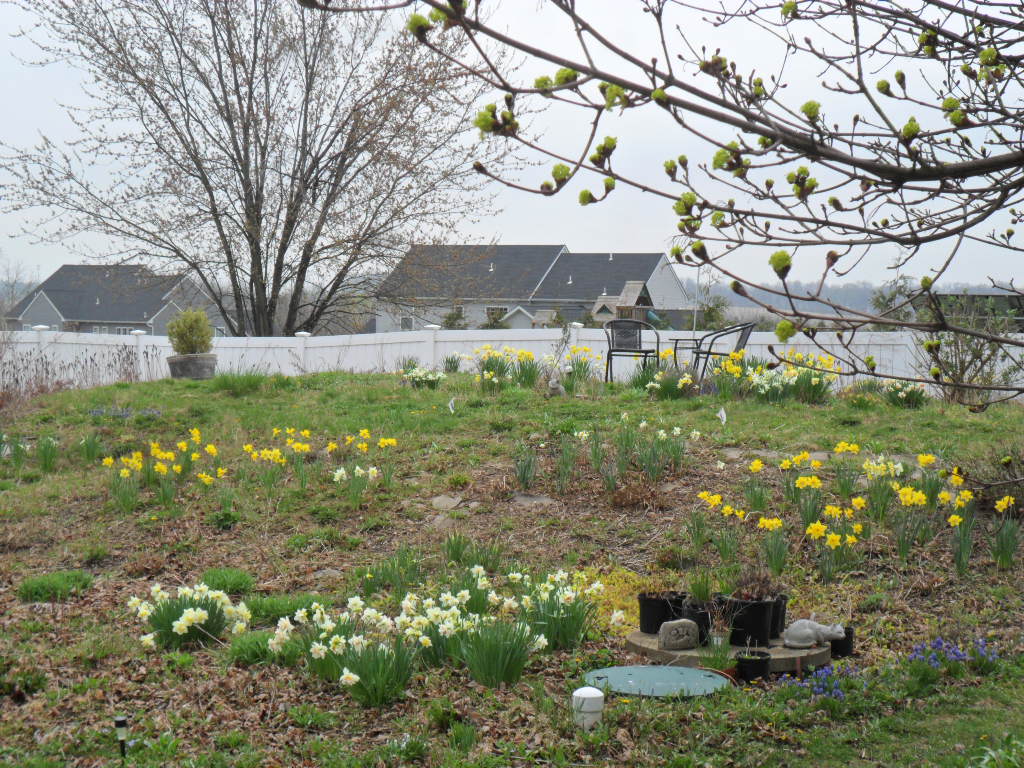

7 comments, add yours.
Rosemary
Alex, They’re beautiful! Thank you for sharing! I enjoyed seeing photos
of different varieties of daffodils, narcissus and hyacinths. I grew up
in Mo. but have lived in Florida most of my life. I miss the spring
flowers we had, growing up. My mother always had a bouquet of
daffodils on the table, this time of year. So fragrant, too!
Sandi
Alex, I am pea green with envy! I only have standard varieties, but they were more productive this year than I can recall in years past.
The double daffodil you pictured – does it have a very heavy scent? I bought bulbs advertised as ‘fall daffodils’ but I think they are what you have, as they do bloom in spring, along with the other bulbs. The scent is very heady, like paper whites when you force them in winter.
This has been a crazy spring otherwise, with all the flowering trees and shrubs totally screwed up in their blooming schedules! My large forsythia didn’t bloom at all, except a few straglers.
Alex Miller
AuthorI haven’t noticed any smell with these, Sandi, but then, my nose isn’t very good. :^) but I can smell paperwhites, so if it’s that strong, then I’d say no, no smell.
edna
They are my favorites, too! Thank you for sharing. It’s astonishing how many different varieties you have growing.
Laurien
I enjoyed these beautiful photos, as always! I wonder if the placement of asteroids like Narcissus and Tulipa might show a fondness for these plants. Something to look for in a gardener’s chart, and there must be more…just found Rosa! Must look into this further! Thanks Alex!
Charlotte
Thank you for sharing all this bounteous beauty, Alex!
Daffodils in particular are my top favourite flowers, I think their strange shape with the insouciant trumpets bouncing in the breeze are totally adorable.
I’ve only once seen a daffodil that wasn’t a lovely sunny buttery yellow (it was a white one), I don’t know why there’s so little variety here where I live.
Where I live is in the southern hemisphere, and the daffodils start blooming absolutey EVERWHERE in early August, which coincides with my birthday. I can get quite cranky if they appear a bit later, and there isn’t a huge bunch in the middle of my birthday table.
PINK daffodils, what next?? I must look into this…
Charlotte
PS Have you ever seen a clivia, Alex? To me, they look like salmon pink agapanthus with much bigger individual blooms. They also come in cream colour.